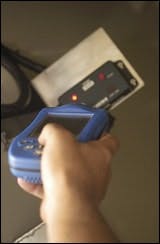It started with a magazine article, says Richard Byrd, vice president of the equipment division of S.W. Rodgers Construction Co., and ended a year later with a decision to use a high-tech approach to reach an old-fashioned bookkeeping goal — increasing the bottom line.
In order to do that, Byrd knew that he had to boost productivity and, at the same time, put a muzzle on fuel costs that were taking larger and larger bites out of his budget.
Up until this time, productivity had been negatively affected because drivers had to spend time manually tracking fuel costs by using "paper tickets." Drivers inserted the tickets into a meter on the truck and started pumping fuel. When they finished, they had to take the ticket out and write down such information as the equipment number and how many hours the unit had on it. It was a "cumbersome process, Byrd says, so productivity suffered since drivers were filling out tickets rather than "moving iron."
He came across the article about a company called OEM Controls (now known as OEM Data Delivery) that delved into how its various systems were used to improve the management of fleets. "I did some homework over a period of time," Byrd says, "and about a year after I read the piece decided to try their technology."
OEM Controls had just introduced a new generation of products when Byrd made the decision to install their Service Tracker and Pump Tracker products.
"Basically, it's a box that you synchronize and install on the machine itself. It tells you which machine it is, how many hours the machine currently has on it, and gives you its service intervals."
The Pump Tracker is installed on all the company's fuel trucks. "Drivers use a hand-held device that is a data collector to scan the equipment," he says. "It meters the fuel and records how many gallons are pumped at that particular time. The operator beams the equipment he is about to fuel, and the system allocates fuel to that particular piece of equipment. When fueling is finished, the operator then beams the fuel truck to complete the transaction. The system confirms the gallons dispensed into that machine. When pumping is finished, the operator uses the hand-held device to download the data from both the Service Tracker and Pump Tracker using a simple point-and-click method to document the transaction."
Not only does the Service Tracker keep tabs on how many gallons of fuel are pumped into what equipment, it also builds a repair history by tracking mechanic activity, says Byrd. This allows him to know what repairs are most common, and the average amount of time required for common maintenance tasks such as oil or belt changes. It also produces "big-picture" information, such as which equipment produces the best return on investment and which equipment has the best profit/loss performance.
When Byrd has to rent equipment, the Service Tracker lets him document when the equipment is being used. When the company finishes with the rental equipment, the system even documents if the rental house, after being notified, is late picking up the equipment. "That prevents a potential disagreement," Byrd says.
Measuring the increase in productivity, Byrd says, "is a tough scenario to put savings on, but the drivers are able to fuel more equipment in less time. That's probably where the productivity comes into play, more so than out in the field."
In addition to obtaining more accurate data, there were safety benefits, Byrd says. "We saw it as a way to free drivers from the task of climbing on machines to get hour-meter readings, often while it was still dark outside, and sometimes when machines were locked and unavailable."
Not only has the technology improved productivity and data accuracy, but by doing so it has also helped Byrd bid jobs more efficiently, he says. In fact, the next thing Byrd is considering is adding more capability to the system that will allow him to also track crew and subcontractors.
S.W. Rodgers has 300 to 350 units with the tracking system. The initial installation was done by OEM Controls, says Byrd, but Rodgers did the rest. "Putting them on the machines takes about an hour per machine, but that's really all the maintenance you have."
Data goes into a DataVault and is reported each night via the Internet. It also makes the information available in a form that is "immediately useful to managers," says Byrd.
The system also saves about 15 minutes per shift, according to Byrd, and since reports are generated each night, the payoff to the company is well worth the investment, he adds.






